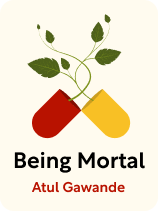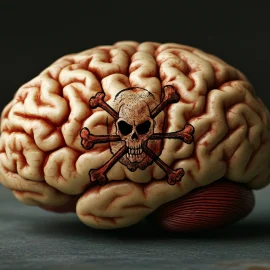

This article is an excerpt from the Shortform book guide to "Being Mortal" by Atul Gawande. Shortform has the world's best summaries and analyses of books you should be reading.
Like this article? Sign up for a free trial here.
What is it like to die in the 21st century? What are the greatest barriers to successful end-of-life care?
People today live longer than ever before thanks to modern medical technology and other advances. However, the process of aging and dying has become worse.
Atul Gawande identifies the following four problems in our modern approach to the end of life.
1. We Don’t Live With the Elderly in Multigenerational Households
One defining feature of the way we experience aging today concerns the typical household, contends Gawande: We no longer live in a multigenerational setting. Research shows that the percentage of elderly people living with their children dropped from 60% in the early 20th century to less than 15% in 1960.
It was once typical for the elderly to live with their children and grandchildren under one roof. These elders usually enjoyed a place of honor in the home and community, maintained personal autonomy, were diligently cared for, retained a sense of belonging and purpose through their final moments, and died among loved ones. Gawande concedes that this arrangement wasn’t always easy, but he suggests that in all these ways, it met many of the core needs of the elderly that we neglect today. Moreover, it made younger generations more aware of mortality by exposing them to the realities of aging and dying.
Despite all these benefits, Gawande offers two reasons why we don’t live together anymore:
First, we don’t honor the elderly. This is largely because people live longer than ever before—reaching old age isn’t that special now. Life expectancy has gradually risen in the developed world since the early 20th century because of advances in medical technology, safer workplaces, and more stable food sources. When life expectancy was short, the rare person who survived into old age would have been honored.
Second, younger and older generations don’t depend on one another for economic security. One reason for this is that job opportunities are more varied than in the past: A child is no longer obliged to take over the family trade. Also, economic safety nets such as Social Security and Medicare in the US provide financial support for the elderly. Because of this, it’s easy for individual family members to forge independent lives for themselves, including living separately.
According to Gawande, we’ve failed to make up for the lost benefits of living with aging parents and grandparents: The elderly still need physical care and a sense of purpose, and we need to see aging and dying as a natural part of life.
2. We Live With Frailty Longer but We Don’t Manage It Well
The second feature of our modern approach to mortality involves the way we handle the aging body. Because more of us reach old age than ever before, more of us live longer with its frailty. Gawande notes that while modern advances help us avoid infection, disease, and accidents better than ever, they haven’t stopped the natural aging process. Worn out from long use, our bones and teeth lose density, our skin thins, we lose muscle mass, and our internal organs begin to malfunction. Accustomed to modern medicine’s ability to restore our health, we haven’t prepared ourselves to live with these inevitable infirmities.
As Gawande sees it, we usually deal with the symptoms of aging as if they can be reversed, but they can’t. He argues that we need to accept the deterioration of the body as natural and focus on supporting the elderly as they face limitations, not on curing them of aging. Unfortunately, non-specialist physicians—accustomed to curing patients through medical interventions—are usually the ones caring for the elderly.
According to Gawande, these physicians often fail to address the everyday physical and emotional challenges of aging. They may focus on blood pressure fluctuations while overlooking poor hygiene caused by reduced flexibility or weight loss caused by loneliness. Gawande suggests that basic needs, such as the ability to get in the shower or enjoy a meal with loved ones, are more critical to an old person’s daily well-being than are the narrow medical issues most doctors focus on.
3. We Relegate the Aging and Dying to Medical Institutions
The third aspect of our modern experience of the end of life deals with our reliance on medical institutions for end-of-life care. In our era of advanced healthcare, we typically relegate the aging and dying to hospitals and nursing homes if they need regular care.
Gawande argues that these institutions fail to provide such patients with adequate autonomy and a sense of belonging. Nursing homes and hospitals are designed for narrow medical aims that are often at odds with the things that add value to life, such as personal freedom and feeling connected to others. In these conditions, residents feel bored, lonely, and depressed.
There have been alternative models of care that try to do a better job, but they’re not commonly practiced, writes Gawande. For example, the original assisted living model of care was designed in the 1980s to promote personal freedom. Residents could live in a comfortable space and direct their own lives—they could choose when they wanted to sleep, what they wanted to eat, and so on. Early studies of these facilities found that residents had improved cognitive and physical health, higher levels of satisfaction, and less depression than those who stayed in nursing homes.
Despite its success, this alternative assisted living model of care is rarely practiced today, though many institutions use the name. According to Keren Brown Wilson (the founder of the model), its failure exposes the ongoing difficulties we face in supporting the deeper needs of the elderly: Institutional priorities—regulations, profits, performance goals, and so on—aren’t aligned with the priorities of the residents.
For example, metrics like blood pressure stats and injury reports often become the gauge of an institution’s success. Since independent people (the elderly included) often minimize their health and safety in favor of doing things they like, such metrics discourage organizations from giving residents autonomy. For instance, an elderly person may not be allowed to go on a nature walk due to the risk of falling. Despite their good intentions, institutions often sacrifice personal freedom and a sense of meaning in support of health, safety, and the bottom line.
4. We Don’t Prepare for the End of Life
One final feature of aging and dying in our modern era is our reluctance to prepare for death. Gawande observes that we rarely contemplate the final days of life—if we’re confronted with an unexpected terminal diagnosis, doctors, patients, and family members often default to a frenetic search for a cure. In this way, we become consumed by anxiety and denial, and we sacrifice a sense of meaning and closure as death approaches.
Gawande asserts that because we lived with ever-present reminders of death for most of human history, we were once accustomed to facing it. Life was full of hazards—incurable diseases, rampant infections, dangerous tasks, and so on. On top of that, we were more accustomed to seeing people, such as elderly family members, die. Expecting your time to come at any moment, it was common to prepare in advance. Getting ill or contracting an infection would have made you realize your time was limited, and you would have accepted that reality: Survival was an unrealistic expectation.
Now, however, advances in medical technology have prolonged the process of dying, writes Gawande. Patients can be kept alive long after their minds are inactive and their bodies immobile. With endless treatment options available, we’ve neglected to accept our mortality—as he sees it, we must relearn how to die.

———End of Preview———
Like what you just read? Read the rest of the world's best book summary and analysis of Atul Gawande's "Being Mortal" at Shortform.
Here's what you'll find in our full Being Mortal summary:
- What it's like to age and die in the 21st century
- Why we need to be better at accepting death
- How to improve the well-being of the aging and dying






